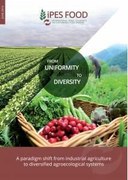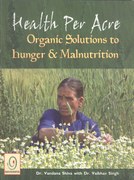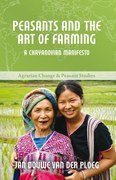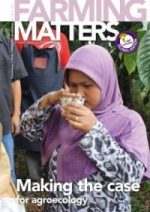From uniformity to diversity

The current industrial agricultural system can provide great amounts of food, but at what price? This report, published by the International Panel of Experts on Sustainable Food Systems (IPES-Food), argues for a diversification of agricultural practices, as opposed to the industrialised monocultures, in order to reach a more sustainable food system. The authors analyse the main failures related to widespread industrial highly-specialised systems: environmental, economic, and social ones. But, although these drawbacks are real, industrial systems keep thriving and expanding: according to the authors this is because they are strongly tied to a whole industrial food system through feedback loops and ‘lock-ins’, which hinder change. After presenting evidence of the positive sides of diversified agroecological systems compared with the industrial monocultures in terms of production, health issues, and environmental conservation, the authors develop recommendations, turning the ‘lock-ins’ into opportunities for change: for example, developing new indicators for evaluating the success of agroecological agriculture, in contrast to the yield focused indicators related to industrial agriculture.
Health per acre

Despite being a fairly aged publication, this book deals with extremely up to date issues. It strongly supports agricultural diversification as a solution to the challenges India is facing: agrarian crisis, rising food prices, hunger and malnutrition. The commonly used ‘yield per acre’ indicator is here contra posed to a ‘nutrition per acre’ one that focuses on the amount of nutrients provided by an agricultural system. Drawing from an introduction on health and nutrition – what are the kind of nutrients that need to be supplied for a healthy body? Where to get them from? – the authors lead us through a variety of Indian case studies that show that the amount of nutrients provided by one acre of organic intercropped farmland is much higher and more various than the amount of nutrients produced by an acre of conventional farmland. The authors thoroughly break down the thesis supporting the green revolution of the past, or the currently debated genetically modified organisms, as solutions to hunger and malnutrition, showing how a nutritious and balanced diet is connected to the food production system much more strongly than we think.
Soil to sky: of agroecology

In this infographic, The Christensen Fund explores the pros and cons of agroecology and industrial agriculture, comparing them at all the different levels in between the ‘soil and sky’. This analysis of distinct agrarian systems does not only involve the environmental dimension, as the title might suggest, but also social, economic and health issues, cleverly put together in this accessible and cartoonlike version of our world. The infographic touches a variety of topics, such as climate strategies, unemployment and migration, local economy, nutrition, wildlife habitats, nutrient cycling and soil erosion. The outcome, as you might have guessed, is a clear endorsement of agroecological strategies as better solutions to the current environmental, economic and social struggles we are facing.
Peasants and the art of farming: A Chayanovian manifesto

In this book, Jan Douwe van der Ploeg offers a reflection of the far reaching and complex transformations of food systems that have occurred at the micro level as a result of liberalisation and globalisation. Focussing on the structure and dynamics of peasant farms and the historically highly variable relations that govern the processes of labour and production within the peasant farms; the author argues that peasant agriculture can play an important, if not central, role in increasing food production sustainably. However, peasants today, as in the past, are materially neglected. By building on the work of Chayanov, this book seeks to address this neglect and to show how important peasants are in the ongoing struggles for food, food sustainability and food sovereignty. The books focuses on the balances entailed in farming and how peasants deal with these, such as the balances between healthy and diverse food for the family, labour quality and drudgery, the farming family’s connection with the past and with the land, soil quality and animal health, linkages with culture and the local economy etc. According to the author, the continuous assessment of the farm’s performance following these criteria is not only what makes peasant farming unique, but also provides guidance for understanding the multiple benefits of farmer-led agroecology.
More on measuring impact
Here are a few more examples of the variety of tools and issues related to assessing the impact of agroecology.
From our own archive, Tracking change (ILEIA Newsletter 12.3, 1996) shows that back in 1996 the search for valid and relevant indicators of sustainable development was already a hot topic. The involvement of grassroots actors in assessing and monitoring their environment is the common thread presented in this issue of the magazine.
Agroecology: the ecology of sustainable food systems (Gliessman, 2014). In this revised version of Gliessman’s book, the ‘Transition to Sustainability’ section specifically focuses on changing from a conventional to an agroecological system, introducing sustainability indicators and the use of an ecosystem framework as evaluation tools.
Didactic Toolkit for the Design, Management and Assessment of Resilient Farming Systems (Third World Network, SOCLA, REDAGRES) (https://foodfirst.org/wp-content/uploads/2015/11/Didactic-Toolkit-TWN-SOCLA.pdf). This manual provides simple and pragmatic tools suitable for farmers and technicians who want to evaluate the resilience of a farming system, convert to an agroecological one, or monitor adaptive responses on a farm.
Farming for the Future: Organic and Agroecological Solutions to Feed the World (Friends of the Earth, 2016) (http://www.foe.org/ projects/food-and-technology/ farming-for-the-future). This report presents an extensive review of research around organic and agroecological farming. While debunking myths about the current food system, the authors provide evidence of agroecology as a solution for feeding our world in the best possible way.
With the Sustainable Development Goals recently approved, several blogs have highlighted the contribution of family farming and agroecology to meeting these goals. Groundswell International has dedicated several blog entries to this topic (http:// www.groundswellinternational.org/agroecology/agroecologyand-the-sustainable-development-goals/). And, the World Rural Forum has brought out a report, Family Farming and the Sustainable Development Agenda(https://www.ruralforum. net/en/news/2016/08/familyfarming-and-the-sustainable-development-agenda), which shows the importance of family farming, specifically for the goal on eradicating hunger.


